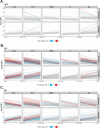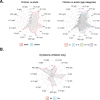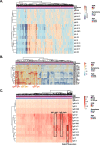Antibody conversion rates to SARS-CoV-2 in saliva from children attending summer schools in Barcelona, Spain
- PMID: 34809617
- PMCID: PMC8608564
- DOI: 10.1186/s12916-021-02184-1
Antibody conversion rates to SARS-CoV-2 in saliva from children attending summer schools in Barcelona, Spain
Abstract
Background: Surveillance tools to estimate viral transmission dynamics in young populations are essential to guide recommendations for school opening and management during viral epidemics. Ideally, sensitive techniques are required to detect low viral load exposures among asymptomatic children. We aimed to estimate SARS-CoV-2 infection rates in children and adult populations in a school-like environment during the initial COVID-19 pandemic waves using an antibody-based field-deployable and non-invasive approach.
Methods: Saliva antibody conversion defined as ≥ 4-fold increase in IgM, IgA, and/or IgG levels to five SARS-CoV-2 antigens including spike and nucleocapsid constructs was evaluated in 1509 children and 396 adults by high-throughput Luminex assays in samples collected weekly in 22 summer schools and 2 pre-schools in 27 venues in Barcelona, Spain, from June 29th to July 31st, 2020.
Results: Saliva antibody conversion between two visits over a 5-week period was 3.22% (49/1518) or 2.36% if accounting for potentially cross-reactive antibodies, six times higher than the cumulative infection rate (0.53%) assessed by weekly saliva RT-PCR screening. IgG conversion was higher in adults (2.94%, 11/374) than children (1.31%, 15/1144) (p=0.035), IgG and IgA levels moderately increased with age, and antibodies were higher in females. Most antibody converters increased both IgG and IgA antibodies but some augmented either IgG or IgA, with a faster decay over time for IgA than IgG. Nucleocapsid rather than spike was the main antigen target. Anti-spike antibodies were significantly higher in individuals not reporting symptoms than symptomatic individuals, suggesting a protective role against COVID-19.
Conclusion: Saliva antibody profiling including three isotypes and multiplexing antigens is a useful and user-friendlier tool for screening pediatric populations to detect low viral load exposures among children, particularly while they are not vaccinated and vulnerable to highly contagious variants, and to recommend public health policies during pandemics.
Keywords: Antibody conversion; Children; SARS-CoV-2; Saliva; Schools.
© 2021. The Author(s).
Conflict of interest statement
The authors declare that they have no competing interests. Professor Carlota Dobaño is Editorial Adviser for BMC Medicine.
Figures



Similar articles
-
Multiplex Antibody Analysis of IgM, IgA and IgG to SARS-CoV-2 in Saliva and Serum From Infected Children and Their Close Contacts.Front Immunol. 2022 Jan 27;13:751705. doi: 10.3389/fimmu.2022.751705. eCollection 2022. Front Immunol. 2022. PMID: 35154094 Free PMC article.
-
A Multiplex Noninvasive Salivary Antibody Assay for SARS-CoV-2 Infection and Its Application in a Population-Based Survey by Mail.Microbiol Spectr. 2021 Oct 31;9(2):e0069321. doi: 10.1128/Spectrum.00693-21. Epub 2021 Sep 15. Microbiol Spectr. 2021. PMID: 34523986 Free PMC article.
-
Transmission of Severe Acute Respiratory Syndrome Coronavirus 2 Infection Among Children in Summer Schools Applying Stringent Control Measures in Barcelona, Spain.Clin Infect Dis. 2022 Jan 7;74(1):66-73. doi: 10.1093/cid/ciab227. Clin Infect Dis. 2022. PMID: 33709138 Free PMC article.
-
[SARS-CoV-2 and Microbiological Diagnostic Dynamics in COVID-19 Pandemic].Mikrobiyol Bul. 2020 Jul;54(3):497-509. doi: 10.5578/mb.69839. Mikrobiyol Bul. 2020. PMID: 32755524 Review. Turkish.
-
Transmission of SARS-CoV-2 in educational settings in 2020: a review.BMJ Open. 2022 Apr 5;12(4):e058308. doi: 10.1136/bmjopen-2021-058308. BMJ Open. 2022. PMID: 35383084 Free PMC article. Review.
Cited by
-
Oral Pathology in COVID-19 and SARS-CoV-2 Infection-Molecular Aspects.Int J Mol Sci. 2022 Jan 27;23(3):1431. doi: 10.3390/ijms23031431. Int J Mol Sci. 2022. PMID: 35163355 Free PMC article. Review.
-
Guardians of the oral and nasopharyngeal galaxy: IgA and protection against SARS-CoV-2 infection.Immunol Rev. 2022 Aug;309(1):75-85. doi: 10.1111/imr.13118. Epub 2022 Jul 11. Immunol Rev. 2022. PMID: 35815463 Free PMC article. Review.
-
Multiplex Antibody Analysis of IgM, IgA and IgG to SARS-CoV-2 in Saliva and Serum From Infected Children and Their Close Contacts.Front Immunol. 2022 Jan 27;13:751705. doi: 10.3389/fimmu.2022.751705. eCollection 2022. Front Immunol. 2022. PMID: 35154094 Free PMC article.
-
Clinical Assessment of SARS-CoV-2 Antibodies in Oral Fluids Following Infection and Vaccination.Clin Chem. 2024 Apr 3;70(4):589-596. doi: 10.1093/clinchem/hvad169. Clin Chem. 2024. PMID: 38039096 Free PMC article. Review.
-
Cross-protective HCoV immunity reduces symptom development during SARS-CoV-2 infection.mBio. 2024 Feb 14;15(2):e0272223. doi: 10.1128/mbio.02722-23. Epub 2024 Jan 25. mBio. 2024. PMID: 38270455 Free PMC article.
References
-
- Bi Q, Wu Y, Mei S, Ye C, Zou X, Zhang Z, Liu X, Wei L, Truelove SA, Zhang T, Gao W, Cheng C, Tang X, Wu X, Wu Y, Sun B, Huang S, Sun Y, Zhang J, Ma T, Lessler J, Feng T. Epidemiology and transmission of COVID-19 in 391 cases and 1286 of their close contacts in Shenzhen, China: a retrospective cohort study. Lancet Infect Dis. 2020;20(8):911–919. doi: 10.1016/S1473-3099(20)30287-5. - DOI - PMC - PubMed
Publication types
MeSH terms
Substances
LinkOut - more resources
Full Text Sources
Medical
Miscellaneous

